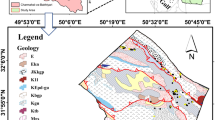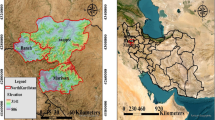Abstract
In the present study, we applied artificial neural network (ANN) optimized with particle swarm optimization (PSO) for the problem of landslide susceptibility mapping (LSM) prediction. Many studies have revealed that the ANN-based techniques are reliable methods for estimating the LSM. However, most ANN training models facing with major problems such as slow degree of learning system as well as being trapped in their local minima. Optimization algorithms (OA) such as PSO can improve performance results of ANN. Existing applications of PSO model to ANN training have not been used in area of landslide mapping, neither assess the optimal architecture of networks nor the influential factors affecting this problem. Hence, the present study focused on the application of a hybrid PSO-based ANN model (PSO-ANN) to the prediction of landslide susceptibility hazardous mapping. To prepare training and testing datasets for the ANN and PSO-ANN network models, large data collection (i.e., a database consists 168970 training datasets and 42243 testing datasets) were provided from an area of Layleh valley, located in Kermanshah, west of Iran. All the variables of PSO algorithm (e.g., in addition to the network parameter and network weights) were optimized to achieve the most reliable maps of landslide susceptibility. The input dataset includes elevation, slope aspect, slope degree, curvature, soil type, lithology, distance to road, distance to river, distance to fault, land use, stream power index (SPI) and topographic wetness index (TWI), where the output was taken landslide susceptibility value. The predicted results (e.g., from ANN, PSO-ANN) for both of datasets (e.g., training and testing) of the models were assessed based on two statistical indices namely, coefficient of determination (R2) and root-mean-squared error (RMSE). In this study, to evaluate the ability of all methods, color intensity rating (CER) based on the result of above indices was developed. Apart from CER, the total ranking system was also used to rank the obtained statistical indexes. As a result, both models presented good performance, however, according to the introduced ranking system, the PSO-ANN model could perform a better performance compared to ANN. According to R2 and RMSE values of (0.9717 and 0.1040) and (0.99131 and 0.0366) were found for training dataset and values of (0.9733 and 0.111) and (0.9899 and 0.0389) obtained for testing dataset, respectively, for the ANN and PSO-ANN approximation models, it can be resulted that PSO-ANN model showed higher reliability in estimating the LSM compared to the ANN.














Similar content being viewed by others
References
Pourghasemi HR, Pradhan B, Gokceoglu C (2012) Application of fuzzy logic and analytical hierarchy process (AHP) to landslide susceptibility mapping at Haraz watershed, Iran. Nat Hazards 63:965–996
Pourghasemi HR, Moradi HR, Aghda SMF, Gokceoglu C, Pradhan B (2014) GIS-based landslide susceptibility mapping with probabilistic likelihood ratio and spatial multi-criteria evaluation models (North of Tehran, Iran). Arab J Geosci 7:1857–1878
Morello R (2018) Potentialities and limitations of thermography to assess landslide risk. Measurement 116:658–668
Vakhshoori V, Zare M (2016) Landslide susceptibility mapping by comparing weight of evidence, fuzzy logic, and frequency ratio methods. Geomat Nat Hazards Risk 7:1731–1752
Ausilio E, Zimmaro P (2017) Landslide characterization using a multidisciplinary approach. Measurement 104:294–301
Pradhan B (2010) Landslide Susceptibility mapping of a catchment area using frequency ratio, fuzzy logic and multivariate logistic regression approaches. J Indian Soc Remote Sens 38:301–320
Hong HY, Naghibi SA, Pourghasemi HR, Pradhan B (2016) GIS-based landslide spatial modeling in Ganzhou City, China. Arab J Geosci 9:26
Sangchini EK, Emami SN, Tahmasebipour N, Pourghasemi HR, Naghibi SA, Arami SA, Pradhan B (2016) Assessment and comparison of combined bivariate and AHP models with logistic regression for landslide susceptibility mapping in the Chaharmahal-e-Bakhtiari Province, Iran. Arab J Geosci 9:15
Umar Z, Pradhan B, Ahmad A, Jebur MN, Tehrany MS (2014) Earthquake induced landslide susceptibility mapping using an integrated ensemble frequency ratio and logistic regression models in West Sumatera Province, Indonesia. Catena 118:124–135
Pourghasemi HR, Pradhan B, Gokceoglu C, Mohammadi M, Moradi HR (2013) Application of weights-of-evidence and certainty factor models and their comparison in landslide susceptibility mapping at Haraz watershed, Iran. Arab J Geosci 6:2351–2365
Pradhan B, Oh HJ, Buchroithner M (2010) Weights-of-evidence model applied to landslide susceptibility mapping in a tropical hilly area. Geomat Nat Hazards Risk 1:199–223
Hebb DO (1949) The organization of behavior: A neurophysiological approach. Wiley, Hoboken
Hasanzadehshooiili H, Mahinroosta R, Lakirouhani A, Oshtaghi V (2014) Using artificial neural network (ANN) in prediction of collapse settlements of sandy gravels. Arab J Geosci 7:2303–2314
Armaghani DJ, Hasanipanah M, Mohamad ET (2016) A combination of the ICA-ANN model to predict air-overpressure resulting from blasting. Eng Comput 32:155–171
Jahed Armaghani D, Hasanipanah M, Tonnizam Mohamad E (2016) A combination of the ICA-ANN model to predict air-overpressure resulting from blasting. Eng Comput 32:155–171
Moayedi H, Armaghani DJ (2017) Optimizing an ANN model with ICA for estimating bearing capacity of driven pile in cohesionless soil. Eng Comput 34(2):347–356
Saghatforoush A, Monjezi M, Faradonbeh RS, Armaghani DJ (2016) Combination of neural network and ant colony optimization algorithms for prediction and optimization of flyrock and back-break induced by blasting. Eng Comput 32:255–266
Moayedi H, Hayati S (2018) Artificial intelligence design charts for predicting friction capacity of driven pile in clay. Neural Comput Appl. https://doi.org/10.1007/s00521-018-3555-5
Mohamad ET, Faradonbeh RS, Armaghani DJ, Monjezi M, Majid MZA (2017) An optimized ANN model based on genetic algorithm for predicting ripping production. Neural Comput Appl 28:393–406
Monjezi M, Baghestani M, Faradonbeh RS, Saghand MP, Armaghani DJ (2016) Modification and prediction of blast-induced ground vibrations based on both empirical and computational techniques. Eng Comput 32:717–728
Armaghani DJ, Tonnizam Mohamad E, Momeni E, Monjezi M, Narayanasamy MS (2016) Prediction of the strength and elasticity modulus of granite through an expert artificial neural network. Arab J Geosci 9:1–16
Hajihassani M, Armaghani DJ, Marto A, Mohamad ET (2015) Ground vibration prediction in quarry blasting through an artificial neural network optimized by imperialist competitive algorithm. Bull Eng Geol Env 74:873–886
Mosallanezhad M, Moayedi H (2017) Developing hybrid artificial neural network model for predicting uplift resistance of screw piles. Arab J Geosci 10:10
Gandomi AH, Alavi AH (2012) A new multi-gene genetic programming approach to non-linear system modeling. Part II: geotechnical and earthquake engineering problems. Neural Comput Appl 21:189–201
Eberhart-Phillips D, Chadwick M (2002) Three-dimensional attenuation model of the shallow Hikurangi subduction zone in the Raukumara Peninsula, New Zealand. J Geophys Res Solid Earth 107:B2
Kennedy J (2011) Particle swarm optimization, encyclopedia of machine learning. Springer, Berlin, pp 760–766
Poli R, Kennedy J, Blackwell T (2007) Particle swarm optimization. Swarm Intell 1:33–57
Armaghani DJ, Hajihassani M, Mohamad ET, Marto A, Noorani SA (2014) Blasting-induced flyrock and ground vibration prediction through an expert artificial neural network based on particle swarm optimization. Arab J Geosci 7:5383–5396
Gordan B, Armaghani DJ, Hajihassani M, Monjezi M (2016) Prediction of seismic slope stability through combination of particle swarm optimization and neural network. Eng Comput 32:85–97
Hasanipanah M, Noorian-Bidgoli M, Armaghani DJ, Khamesi H (2016) Feasibility of PSO-ANN model for predicting surface settlement caused by tunneling. Eng Comput 32:705–715
Mohamad ET, Armaghani DJ, Momeni E, Yazdavar AH, Ebrahimi M (2016) Rock strength estimation: a PSO-based BP approach. Neural Comput Appl 30(5):1635–1646
Devkota KC, Regmi AD, Pourghasemi HR, Yoshida K, Pradhan B, Ryu IC, Dhital MR, Althuwaynee OF (2013) Landslide susceptibility mapping using certainty factor, index of entropy and logistic regression models in GIS and their comparison at Mugling-Narayanghat road section in Nepal Himalaya. Nat Hazards 65:135–165
Sezer EA, Pradhan B, Gokceoglu C (2011) Manifestation of an adaptive neuro-fuzzy model on landslide susceptibility mapping: Klang valley, Malaysia. Expert Syst Appl 38:8208–8219
Zare M, Pourghasemi HR, Vafakhah M, Pradhan B (2013) Landslide susceptibility mapping at Vaz Watershed (Iran) using an artificial neural network model: a comparison between multilayer perceptron (MLP) and radial basic function (RBF) algorithms. Arab J Geosci 6:2873–2888
Pei H, Zhang S, Borana L, Zhao Y, Yin J (2018) Slope stability analysis based on real-time displacement measurements. Measurement 131:686–693
Pradhan B (2013) A comparative study on the predictive ability of the decision tree, support vector machine and neuro-fuzzy models in landslide susceptibility mapping using GIS. Comput Geosci 51:350–365
Pradhan B, Sezer EA, Gokceoglu C, Buchroithner MF (2010) Landslide Susceptibility Mapping by Neuro-Fuzzy Approach in a Landslide-Prone Area (Cameron Highlands, Malaysia). IEEE Trans Geosci Remote Sens 48:4164–4177
Pourghasemi HR, Beheshtirad M, Pradhan B (2016) A comparative assessment of prediction capabilities of modified analytical hierarchy process (M-AHP) and Mamdani fuzzy logic models using Netcad-GIS for forest fire susceptibility mapping. Geomat Nat Hazards Risk 7:861–885
Faradonbeh RS, Monjezi M, Armaghani DJ (2016) Genetic programing and non-linear multiple regression techniques to predict backbreak in blasting operation. Eng Comput 32:123–133
Armaghani DJ, Hasanipanah M, Amnieh HB, Mohamad ET (2016) Feasibility of ICA in approximating ground vibration resulting from mine blasting. Neural Comput Appl 29(9):457–465
Armaghani DJ, Shoib R, Faizi K, Rashid ASA (2017) Developing a hybrid PSO-ANN model for estimating the ultimate bearing capacity of rock-socketed piles. Neural Comput Appl 28(2):391–405
Yusof MF, Azamathulla HM, Abdullah R (2014) Prediction of soil erodibility factor for Peninsular Malaysia soil series using ANN. Neural Comput Appl 24:383–389
Rana MJ, Shahriar MS, Shafiullah M (2017) Levenberg–Marquardt neural network to estimate UPFC-coordinated PSS parameters to enhance power system stability. Neural Comput Appl. https://doi.org/10.1007/s00521-017-3156-8
Siddiqui FI, Pathan DM, Osman S, Pinjaro MA, Memon S (2015) Comparison between regression and ANN models for relationship of soil properties and electrical resistivity. Arab J Geosci 8:6145–6155
Liang M, Mohamad ET, Faradonbeh RS, Armaghani DJ, Ghoraba S (2016) Rock strength assessment based on regression tree technique. Eng Comput 32:343–354
Moayedi H, Rezaei A (2017) An artificial neural network approach for under-reamed piles subjected to uplift forces in dry sand. Neural Comput Appl. https://doi.org/10.1007/s00521-017-2990-z
Koopialipoor M, Armaghani DJ, Hedayat A, Marto A, Gordan B (2018) Applying various hybrid intelligent systems to evaluate and predict slope stability under static and dynamic conditions. Soft Comput. https://doi.org/10.1007/s00500-018-3253-3
Gupta R, Goyal K, Yadav N (2016) Prediction of Safe Bearing Capacity of Noncohesive Soil in Arid Zone Using Artificial Neural Networks. Int J Geomech 16:7
Momeni E, Armaghani DJ, Hajihassani M (2015) Prediction of uniaxial compressive strength of rock samples using hybrid particle swarm optimization-based artificial neural networks. Measurement 60:50–63
Moayedi H, Hayati S (2018) Modelling and optimization of ultimate bearing capacity of strip footing near a slope by soft computing methods. Appl Soft Comput 66:208–219
Author information
Authors and Affiliations
Corresponding author
Ethics declarations
Conflict of interest
The authors declare no conflict of interest.
Additional information
Publisher’s Note
Springer Nature remains neutral with regard to jurisdictional claims in published maps and institutional affiliations.
Rights and permissions
About this article
Cite this article
Moayedi, H., Mehrabi, M., Mosallanezhad, M. et al. Modification of landslide susceptibility mapping using optimized PSO-ANN technique. Engineering with Computers 35, 967–984 (2019). https://doi.org/10.1007/s00366-018-0644-0
Received:
Accepted:
Published:
Issue Date:
DOI: https://doi.org/10.1007/s00366-018-0644-0




